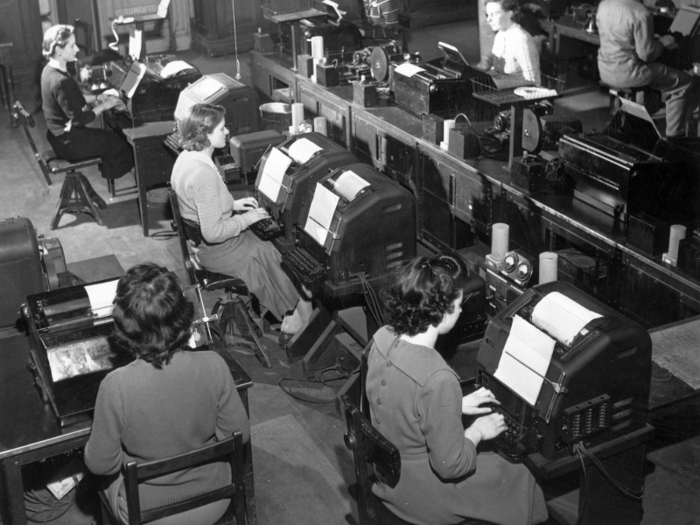
Source: "The Best Place to Work: The Art and Science of Creating an Extraordinary Workplace"

Source: "The Best Place to Work: The Art and Science of Creating an Extraordinary Workplace"

Source: "The Best Place to Work: The Art and Science of Creating an Extraordinary Workplace," Herman Miller

Source: "The Best Place to Work: The Art and Science of Creating an Extraordinary Workplace," Herman Miller

Source: "The Best Place to Work: The Art and Science of Creating an Extraordinary Workplace," "The Cornell School of Hotel Administration on Hospitality: Cutting Edge Thinking and Practice"

Source: "The Best Place to Work: The Art and Science of Creating an Extraordinary Workplace," "The Cornell School of Hotel Administration on Hospitality: Cutting Edge Thinking and Practice"

Source: "Clearing the Air: The Rise and Fall of Smoking in the Workplace," "Amy Vanderbilt's New Complete Book of Etiquette: The Guide to Gracious Living"

Source: "Working in America: Continuity, Conflict, and Change," Business Insider

Source: "Working in America: Continuity, Conflict, and Change"

Source: "Working in America: Continuity, Conflict, and Change," The Atlantic

Source: "Working in America: Continuity, Conflict, and Change," Brookings

Source: "No Seat at the Table: How Corporate Governance and Law Keep Women Out of the Boardroom"

Source: "Amy Vanderbilt's New Complete Book of Etiquette: The Guide to Gracious Living"

Source: Vox, The Week, "Sexual Harassment at the Workplace"

Source: "Amy Vanderbilt's New Complete Book of Etiquette: The Guide to Gracious Living"

Source: The Atlantic, Smoker History, "Dying for a Cigarette: Who's to Blame?"

Source: The Atlantic, Smoker History, "Dying for a Cigarette: Who's to Blame?"


Source: "The Best Place to Work: The Art and Science of Creating an Extraordinary Workplace"

Source: "The Best Place to Work: The Art and Science of Creating an Extraordinary Workplace"

Source: Not Even Past

Source: Not Even Past, The Atlantic

Source: The National Academies Press

Source: "Organizational culture, subcultures, and organizational commitment"

Source: The Washington Post

Source: The Washington Post

Source: The Washington Post

Source: "Cubed: A Secret History of the Workplace"

Source: The Guardian

Source: "The Best Place to Work: The Art and Science of Creating an Extraordinary Workplace"

Source: Business Insider, Business Insider, Business Insider, Business Insider

Source: "The Cornell School of Hotel Administration on Hospitality: Cutting Edge Thinking and Practice"

Source: Business Insider, Business Insider
 I spent $2,000 for 7 nights in a 179-square-foot room on one of the world's largest cruise ships. Take a look inside my cabin.
I spent $2,000 for 7 nights in a 179-square-foot room on one of the world's largest cruise ships. Take a look inside my cabin. Colon cancer rates are rising in young people. If you have two symptoms you should get a colonoscopy, a GI oncologist says.
Colon cancer rates are rising in young people. If you have two symptoms you should get a colonoscopy, a GI oncologist says. Saudi Arabia wants China to help fund its struggling $500 billion Neom megaproject. Investors may not be too excited.
Saudi Arabia wants China to help fund its struggling $500 billion Neom megaproject. Investors may not be too excited. Catan adds climate change to the latest edition of the world-famous board game
Catan adds climate change to the latest edition of the world-famous board game
 Tired of blatant misinformation in the media? This video game can help you and your family fight fake news!
Tired of blatant misinformation in the media? This video game can help you and your family fight fake news!
 Tired of blatant misinformation in the media? This video game can help you and your family fight fake news!
Tired of blatant misinformation in the media? This video game can help you and your family fight fake news!

Copyright © 2024. Times Internet Limited. All rights reserved.For reprint rights. Times Syndication Service.